Elevated IGFBP4 and Cognitive Impairment in a PTFE-Induced Mouse Model of Obstructive Sleep Apnea
- PMID: 40806552
- PMCID: PMC12348007
- DOI: 10.3390/ijms26157423
Elevated IGFBP4 and Cognitive Impairment in a PTFE-Induced Mouse Model of Obstructive Sleep Apnea
Abstract
Obstructive sleep apnea (OSA) is a prevalent disorder linked to metabolic complications such as diabetes and cardiovascular disease. By fragmenting normal sleep architecture, OSA perturbs the growth hormone/insulin-like growth factor (GH/IGF) axis and alters circulating levels of IGF-binding proteins (IGFBPs). A prior clinical observation of elevated IGFBP4 in OSA patients motivated the present investigation in a controlled animal model. Building on the previously reported protocol, OSA was induced in male C57BL/6 mice (9-12 weeks old) through intralingual injection of polytetrafluoroethylene (PTFE), producing tongue hypertrophy, intermittent airway obstruction, and hypoxemia. After 8-10 weeks, the study assessed (1) hypoxia biomarkers-including HIF-1α and VEGF expression-and (2) neurobehavioral outcomes in anxiety and cognition using the open-field and novel object recognition tests. PTFE-treated mice exhibited a significant increase in circulating IGFBP4 versus both baseline and control groups. Hepatic Igfbp4 mRNA was also upregulated. Behaviorally, PTFE mice displayed heightened anxiety-like behavior and impaired novel object recognition, paralleling cognitive deficits reported in human OSA. These findings validate the PTFE-induced model as a tool for studying OSA-related hypoxia and neurocognitive dysfunction, and they underscore IGFBP4 as a promising biomarker and potential mediator of OSA's systemic effects.
Keywords: IGFBP4; OSA animal model; biomarker; hypoxia; novel object recognition; obstructive sleep apnea; open field test.
Conflict of interest statement
The authors declare no conflicts of interest.
Figures

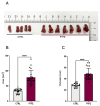

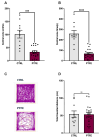
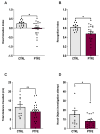
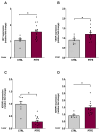
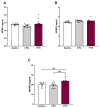
Similar articles
-
Sex differences in endocrine, metabolic and psychological disturbance in obese patients with OSA.Biol Sex Differ. 2025 Jul 1;16(1):48. doi: 10.1186/s13293-025-00730-7. Biol Sex Differ. 2025. PMID: 40598676 Free PMC article.
-
Twelve-Month CPAP Therapy Modulates BDNF Levels in Patients with Severe Obstructive Sleep Apnea: Implications for Metabolic and Treatment Compliance.Int J Mol Sci. 2025 Jun 18;26(12):5855. doi: 10.3390/ijms26125855. Int J Mol Sci. 2025. PMID: 40565316 Free PMC article.
-
Intermittent Hypoxia Induces Cognitive Dysfunction and Hippocampal Gene Expression Changes in a Mouse Model of Obstructive Sleep Apnea.Int J Mol Sci. 2025 Aug 3;26(15):7495. doi: 10.3390/ijms26157495. Int J Mol Sci. 2025. PMID: 40806623 Free PMC article.
-
Effects of opioid, hypnotic and sedating medications on sleep-disordered breathing in adults with obstructive sleep apnoea.Cochrane Database Syst Rev. 2015 Jul 14;(7):CD011090. doi: 10.1002/14651858.CD011090.pub2. Cochrane Database Syst Rev. 2015. PMID: 26171909
-
Hypoxia-inducible factor 1alpha and vascular endothelial growth factor in Glioblastoma Multiforme: a systematic review going beyond pathologic implications.Oncol Res. 2024 Jul 17;32(8):1239-1256. doi: 10.32604/or.2024.052130. eCollection 2024. Oncol Res. 2024. PMID: 39055895 Free PMC article.
References
MeSH terms
Substances
LinkOut - more resources
Full Text Sources
Miscellaneous

